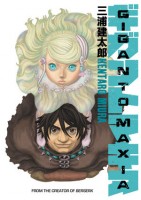Kentaro Miura’s Berserk is a rite of passage for manga readers: you may not have soldiered past the second volume, but you tried because a Real Manga Fan told you that it was The Most Amazing Manga Ever. I freely admit that I didn’t finish Berserk–too violent for me, I’m afraid–but I marveled at its intricate plotting, feverish pace, and deadly seriousness. (Also: Miura’s penchant for awful names.) When Dark Horse announced that it had acquired Giganto Maxia, I decided to treat this new series as a second “date” with Miura–a chance to decide if I’d judged his work unfairly the first time around. Here’s how that date went.
 Giganto Maxia
Giganto Maxia
By Kentaro Miura
Rated 16+, for older teens
Dark Horse, $13.99
Let’s start with the good: Giganto Maxia is a visual feast that’s every bit as imaginative as Hayao Mizayaki’s Nausicaa of the Valley of the Wind. Kentaro Miura’s pages abound in war-ravaged landscapes, fantastic fighting machines, and bizarre creatures that straddle the fence between human and animal. The specificity of his vision, and the care with which he stages battle scenes, obviates the need for dialogue; we can almost hear and feel what the characters are experiencing on every page.
Miura’s script, however, is as tin-eared and self-serious as a high school literary rag. The two leads–Prome, a pale mystic who looks like a young girl, and Delos, a warrior slave–spend an inordinate amount of time describing what’s happening around them, even when the pictures make it abundantly clear. Yet for all their chatter, neither character provides much useful information about the post-apocalyptic world in which Giganto Maxia takes place: who are the Olympians? Why are they so intent on annihilating other tribes? And what, exactly, are the Giganto? The absence of these details leaves a big hole in the story: the characters’ motivation for fighting the Giganto. At the end of the volume, we’re not really sure what Prome and Delos stand for, or what’s at stake if they fail–two fatal flaws in a series that desperately wants the reader to get swept up in their quest.
The bottom line: A talky script and barely-there characters sink this smart-looking fantasy series.
The publisher provided a review copy.
Reviews: Sean Gaffney and Michelle Smith round up the latest volumes of Arpeggio of Blue Steel, Kimi ni Todoke, and Non Non Biyori at Manga Bookshelf; Sean also reads The Testament of New Sister Devil so that you don’t have to. Over at Women Write About Comics, Amanda Vail and Paige Sammartino offer “short & sweet” reviews of Barakamon, Are You Alice?, and My Hero Academia.
Nick Creamer on vol. 3 of The Ancient Magus’ Bride (Anime News Network)
Gary Thompson on vol. 10 of Black Jack (The Fandom Post)
Demelza on Fairy Tail (Anime UK News)
Megan R. on Gate 7 (The Manga Test Drive)
Nick Creamer on vol. 7 of Genshiken: Second Season (Anime News Network)
Sean Rogers on A Girl on the Shore (The Globe and Mail)
Sheena McNeil on vol. 1 of Honey So Sweet (Sequential Tart)
Rebecca Silverman on vol. 1 of Honey So Sweet (Anime News Network)
Matt on vol. 2 of Inuyashiki (AniTAY)
Sean Gaffney on Kagerou Daze III: The Children Reason (A Case Suitable for Treatment)
Claire Napier on Memoirs of Amorous Gentlemen (Comics Alliance)
Michael Burns on vol. 13 of Nisekoi (AniTAY)
Matthew Warner on vol. 76 of One Piece (The Fandom Post)
Matthew Warner on vol. 3 of One-Punch Man (The Fandom Post)
Rebecca Silverman on vol. 4 of One-Punch Man (Anime News Network)
Matthew Warner on vol. 3 of Peepo Choo (The Fandom Post)
Sheena McNeil on vol. 5 of Pokemon X.Y. (Sequential Tart)
Helen on vol. 1 of ReLife (The OASG)
Matt on vol. 4 of A Silent Voice (AniTAY)
Saeyong Kim on vol. 3 of Thermae Romae (No Flying No Tights)
Sarah on Tsubasa WoRLD CHRoNiCLE: Niraikani (Anime UK News)
Charlotte Finn on Wandering Son (Comics Alliance)